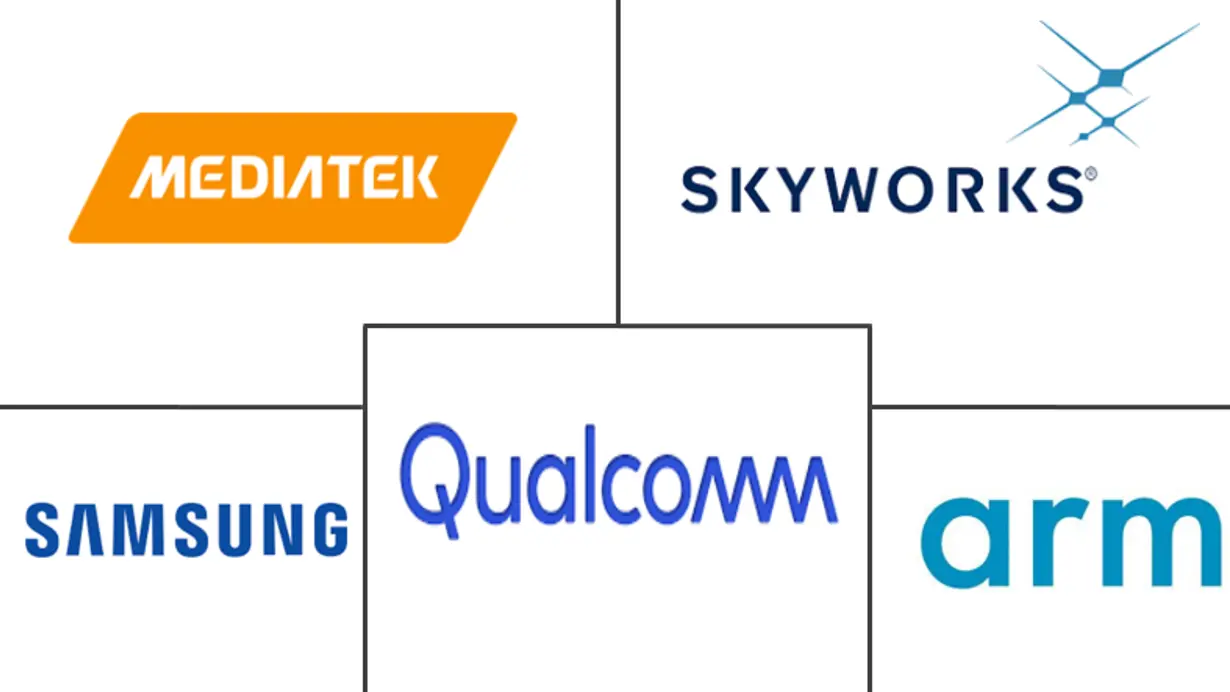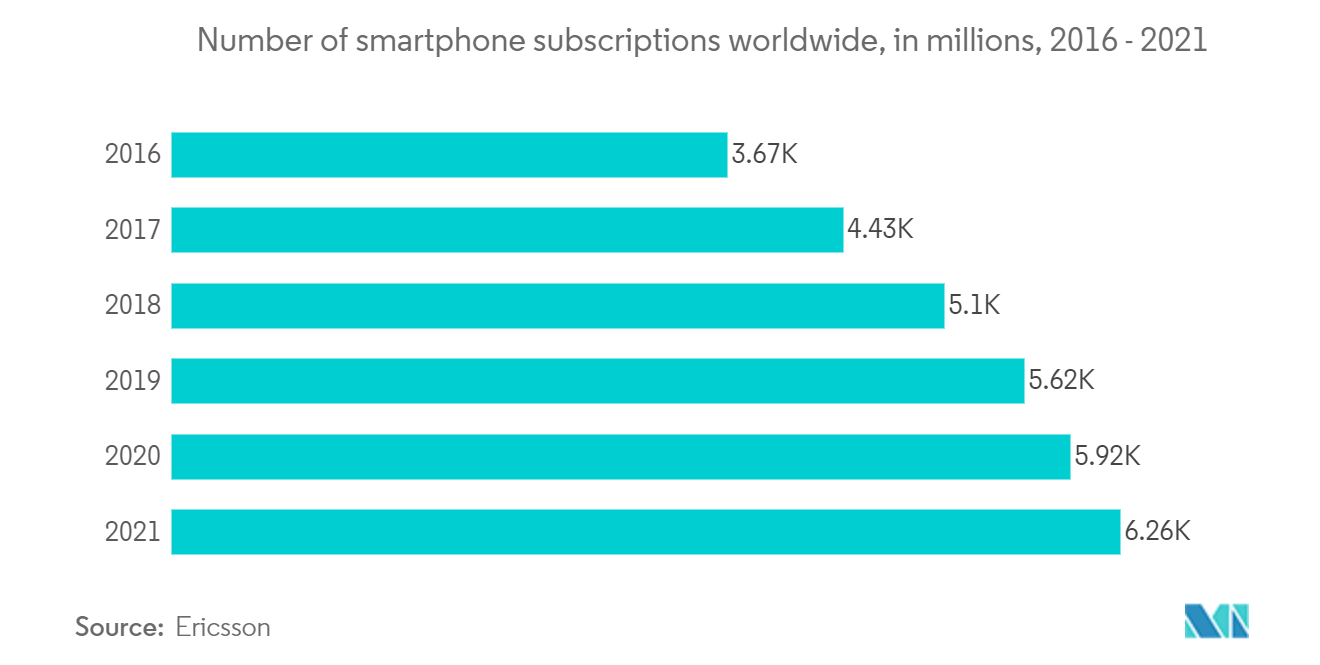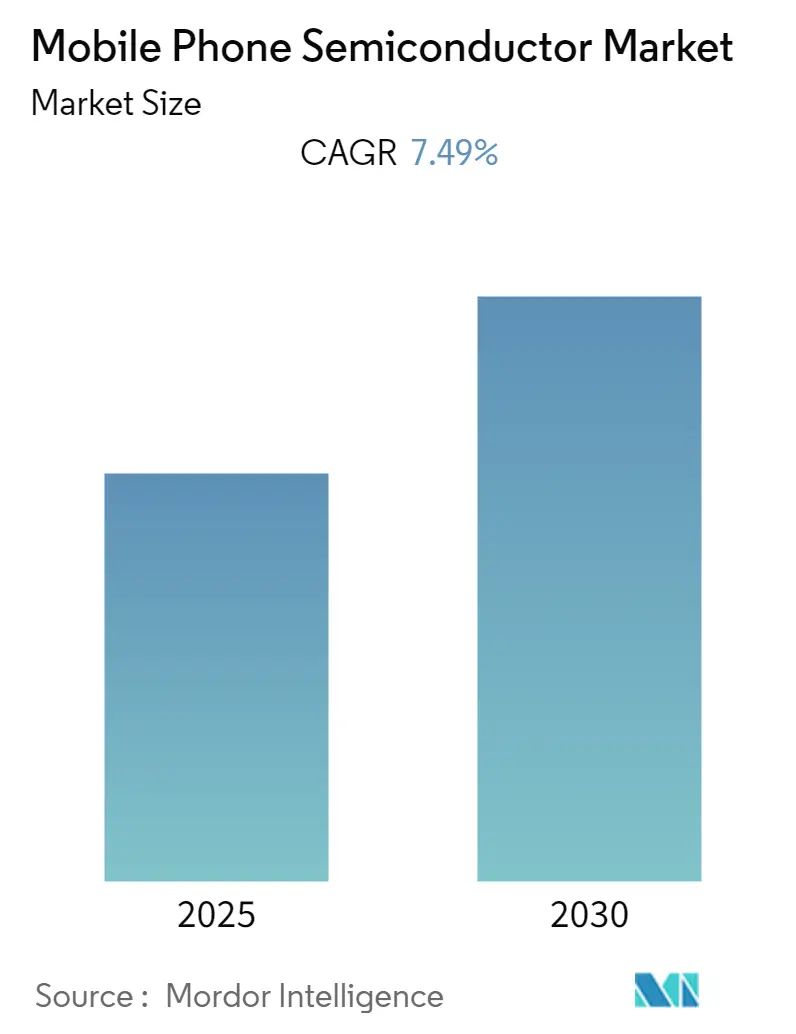
| Study Period | 2019 - 2030 |
| Base Year For Estimation | 2024 |
| Forecast Data Period | 2025 - 2030 |
| CAGR | 7.49 % |
| Fastest Growing Market | Asia Pacific |
| Largest Market | Asia Pacific |
| Market Concentration | Low |
Major Players*Disclaimer: Major Players sorted in no particular order |
Mobile Phone Semiconductor Market Analysis
The Mobile Phone Semiconductor Market is expected to register a CAGR of 7.49% during the forecast period.
- The overall semiconductor industry witnessed lesser growth, and the smartphone business was also fluctuating. However, the mobile phone semiconductor market was able to witness marginal growth, owing to the increasing adoption of RF-based applications in smartphones. In many regions, especially Asia-Pacific, the smartphone business was the largest consumer of the semiconductor industry.
- Since the past year, the smartphone industry has been witnessing a nearing maturity state which is affecting the mobile phone semiconductor industry. However, with the advent of 5G technology and the government's approval for the adoption of 5G technology, it is expected to enable smartphone users to shift from phones supporting 4G and LTE technology to 5G technology which would create huge opportunities for the studied market.
- With the increasing shipments of mobile devices such as tablets, smartphones, and e-book readers have been growing and are driving the growth for a range of semiconductor components, including applications processors, modems, MEMS sensors, wireless connectivity ICs, and audio ICs in these devices.
- The increased revenue of RF was generated from its growing adoption among more bands, a larger number of carriers aggregated, and higher-order MIMO configurations supported by an increase in smartphone ASPs. This trend was expected to continue in 2019, with the addition of the mid-band spectrum for sub-6GHz 5G and mmWave modules in some 5G phones.
- Changes in the semiconductor supply chain, the market fluctuation due to the US-China trade war, the Russia-Ukrain war, and the shifting business models created opportunities for some manufacturers while posing a threat to others.
- However, the significant outbreak of the COVID-19 pandemic globally disrupted the supply chain and production, especially in the Asia-Pacific region. Major semiconductor manufacturing industries have been significantly affected as a result of Asia-Pacific being a world production center over the past two to three decades.
Mobile Phone Semiconductor Market Trends
Memory to Significantly Drive the Market
- A large portion of the growth in this segment would be driven by ongoing technological advancements such as cloud computing and virtual reality in end devices such as smartphones. Sharply higher average selling prices (ASPs) for dynamic random access memory (DRAM) and NAND flash chips also substantially generate revenues.
- In general, the expected price decreases would be offset by new capacity for flash memory and for DRAM, which would result in a better balance of supply and demand for these devices to support more latest applications such as enterprise solid-state drives (SSDs), augmented and virtual reality, artificial intelligence, graphics, and other complexes, real-time workload functions.
- However, emerging memory technologies are poised to cannibalize huge chunks of the DRAM demand in the industry. In August 2022, Micron Technology Inc., announced its plan to spend USD 40 billion through 2030 to expand its semiconductor production capacity in the United States.
- Micron's DRAM chips are used for applications in a variety of devices ranging from smartphones to data center servers. The company's plan to expand its manufacturing unit in the United States is expected to be supported by various credits and grants under the CHIPS and Science Act. Such initiatives by the company is expected to promote the demand for memory in the market providing a positive push to the mobile phone semiconductor market during the forecast period.
Asia-Pacific to Hold a Dominant Position in the Mobile Phone Semiconductor Market
- Asia-Pacific is one of the major markets for mobile phone and semiconductor technologies. The region is dominating semiconductor and smartphone manufacturing fields. Most of the major companies, in both the markets, are based in the Asia-Pacific region, while the remaining companies have a presence in the region.
- The region also dominates the global semiconductor market. The increasing smartphone and semiconductor production, especially in emerging countries, is also augmenting the mobile semiconductor demand in the region. Countries like India, Vietnam, Thailand, and Singapore, among others, are witnessing an increasing number of smartphone manufacturers setting up their manufacturing plants in the region.
- For instance, in November 2022, Apple announced its plan to open one of its largest manufacturing unit in India under the 'Make in India' initiative by the Indian Government. The new manufacturing unit is expected to be Apple's largest manufacturing unit in the region. Such initiatives by the company in the region are expected to ppromote the mobile pone semiconductor market in the region.
- China, South Korea, Japan, Singapore, and Taiwan are some of the highly developed semiconductor producers in the region. However, countries, like Malaysia and India, are also emerging as potential markets. The smartphone market is also massive in these countries; hence, they can offer enormous opportunity for the market studied too. Malaysia is emerging as one of the vital semiconductor export markets.
- In May 2021, South Korea announced its ambitious plans to spend roughly USD 450 billion to build the world's biggest chipmaking base over the next decade. joining China and the U.S. in a global race to dominate the key technology. Moreover, with the shift of various major companies to the
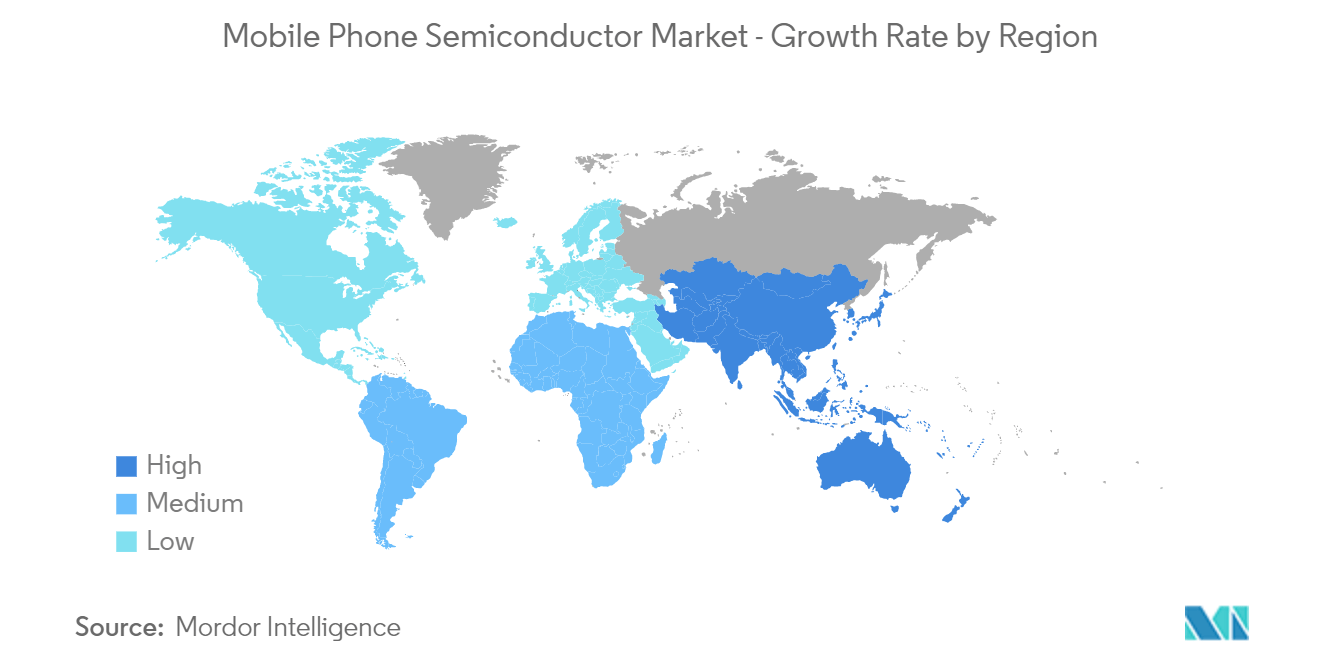
Mobile Phone Semiconductor Industry Overview
The Mobile Phone Semiconductor Market is a highly fragmented market, dominated by several major players. Various acquisitions and collaborations of large companies have taken place and are expected to take place shortly, which focus on innovation. Some of the key players in the market are Samsung Electronics and Qualcomm Technologies, Inc. These companies are leveraging strategic collaborative initiatives to increase their market share and increase their profitability.
- August 2022 - Micron Technology Inc. announced its plan to spend USD 40 billion through 2030 to expand its semiconductor production capacity in the United States. The new manufacturing unit is expected to help the company to increase its manufacturing capabilities in the market.
Mobile Phone Semiconductor Market Leaders
-
Samsung Electronics
-
Arm Limited
-
Qualcomm Technologies, Inc.
-
MediaTek Inc.
-
Skyworks Solutions Inc.
- *Disclaimer: Major Players sorted in no particular order
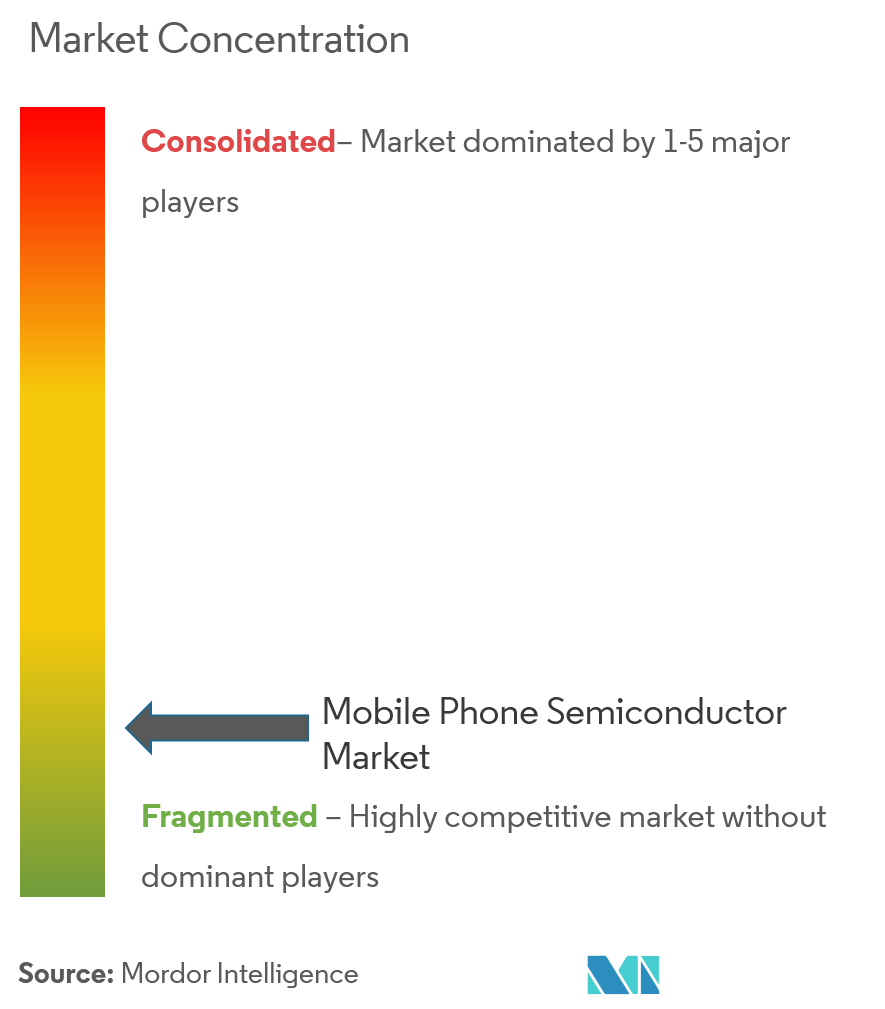
Mobile Phone Semiconductor Market News
- November 2022 - Micron Technology launched its 1-beta DRAM with an aim to improve power efficiency by 15% and bit density by 35% for memory chips. The new DRAM chips would underpin a new generation of memory chips for Micron.
- October 2022 - Polymatech, a semiconductor chip manufacturer powered by Japanese technology, was initiated by the production of its Opto-semiconductors and memory modules. In line with the launch of the Opto-semiconductors and memory modules is a part of the company's massive business expansion and investments of USD 1 billion in semiconductor chip manufacturing.
Mobile Phone Semiconductor Industry Segmentation
The Mobile phone semiconductor market encompasses the semiconductors that are used in mobile phones. The increasing usage and adoption of smartphones are resulting in the growing usage of semiconductors in these devices.
The Mobile Phone Semiconductor Market is segmented by Component Type (Mobile Processors, Memory, Logic Chips, Analog), and Geography (North America, Europe, Asia Pacific, Latin America, MEA). The market sizes and forecasts are provided in terms of value (USD million) for all the above segments.
| Component Type | Mobile Processors |
| Memory | |
| Logic Chips | |
| Analog | |
| Geography | North America |
| Europe | |
| Asia Pacific | |
| Latin America | |
| Middle East and Africa |
Mobile Phone Semiconductor Market Research FAQs
What is the current Mobile Phone Semiconductor Market size?
The Mobile Phone Semiconductor Market is projected to register a CAGR of 7.49% during the forecast period (2025-2030)
Who are the key players in Mobile Phone Semiconductor Market?
Samsung Electronics, Arm Limited, Qualcomm Technologies, Inc., MediaTek Inc. and Skyworks Solutions Inc. are the major companies operating in the Mobile Phone Semiconductor Market.
Which is the fastest growing region in Mobile Phone Semiconductor Market?
Asia Pacific is estimated to grow at the highest CAGR over the forecast period (2025-2030).
Which region has the biggest share in Mobile Phone Semiconductor Market?
In 2025, the Asia Pacific accounts for the largest market share in Mobile Phone Semiconductor Market.
What years does this Mobile Phone Semiconductor Market cover?
The report covers the Mobile Phone Semiconductor Market historical market size for years: 2019, 2020, 2021, 2022, 2023 and 2024. The report also forecasts the Mobile Phone Semiconductor Market size for years: 2025, 2026, 2027, 2028, 2029 and 2030.
Our Best Selling Reports
Mobile Phone Semiconductor Industry Report
Statistics for the 2025 Mobile Phone Semiconductor market share, size and revenue growth rate, created by Mordor Intelligence™ Industry Reports. Mobile Phone Semiconductor analysis includes a market forecast outlook for 2025 to 2030 and historical overview. Get a sample of this industry analysis as a free report PDF download.

